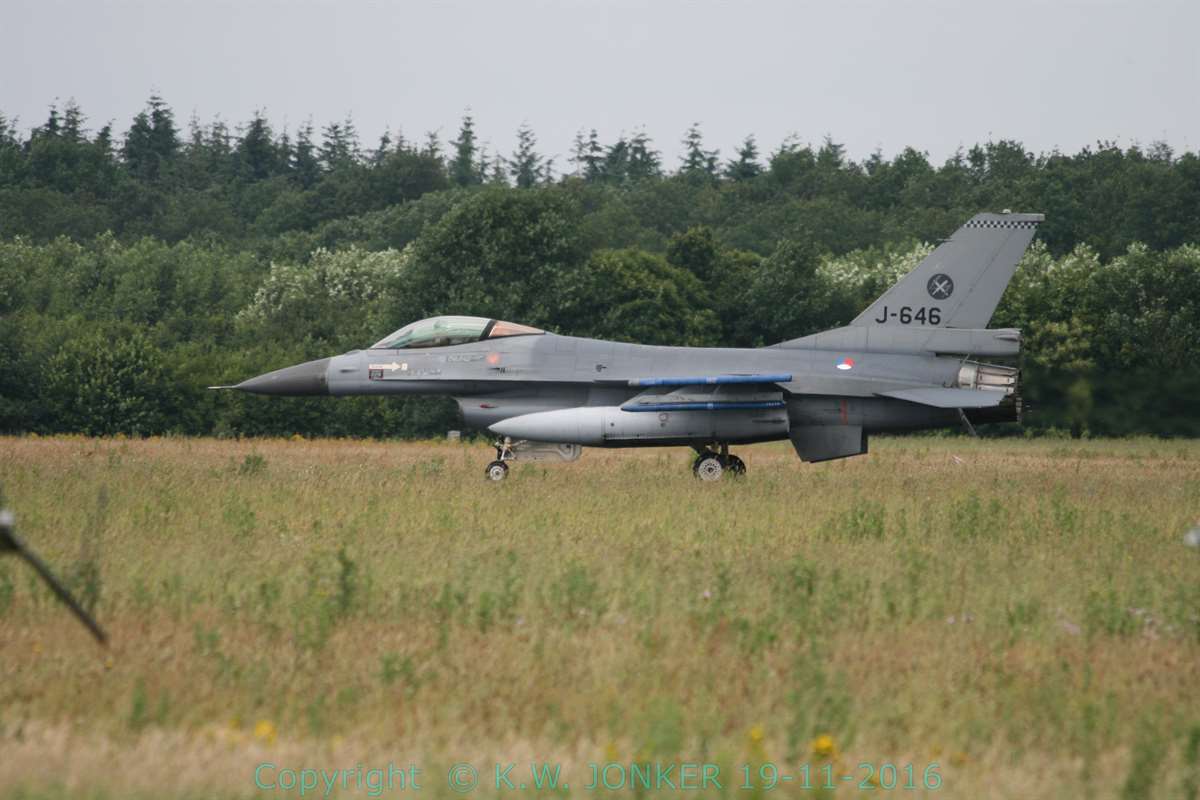Nederlandse Modelbouw en Luchtvaartsite
Dutch Modelling and Aviation
General Dynamics F-16A(M)
Page 2 of 6
The F-16 replaced the Lockheed F-104G Starfighter as standard air defence fighter (clear weather) and to a certain extend also as fighter-bomber (used with the so called tactical squadrons 311 and 312).
During the eighties the Dutch government was looking for a replacement of the old Northrop NF-5 fighter-bomber and soon the decision was made and the F-16 was chosen to also replace the NF-5.
The task of the F-16 has changed from fighter and fighter-bomber to that of a multi-role aircraft.
Recce
Initial the Royal netherlands Air Force use the Orpheus pod, also used with the Lockheed RF-104G Starfighter. Several F-16s, designated as F-16A (R) had special wiring to use with the Orpheus.
The Orpheus pod was withdrawn from use in 1994 as it could be used at medium height. Al existing and operational F-16s were upgraded to MLU standard during the late nineties. All F-16s, especcially the BLokc15 version, were identical to each other.
As an interim solution it was replaced with the MARS, Medium latitude Reconnaissance System.
Later the Reccelite, developed from the Lantirn targeting pod, was bought.
Upgrades and Modifications.
Below an overview of the most important modifications applied the the (Dutch) F-16.
In case you need an extensive overview check http://wiki.scramble.nl/index.php/F-16#Technology_demonstrators.2C_modifications_and_studies
Some modification were necessary for a technical life extension because some parts of the airframe showed tiny cracks, much earlier than expected. These modifications were aslo nexcessary because of the delay of the delivery the succesor of the F-16.
1982-1983: Pacer Loft I and Pacer Loft II
All Block 1 and Block 5 airfcraft were modified to Block 10 standard.
1986 and on: Pacer Bond
J-358, delivered September 5, 1986, was the first Diutch F-16A which had the “Have Glass” canopy modification applied.
The canopy had a thin layer material added in order to reduce the RCS (Radar Cross Section) of the F-16. This modification was part of the 'Have Glass' modificatie.
1988/1989 Pacer Mud
Several parts, such as the edge of the air intake, had a layer RAM (Radar Absorbing material) applied in order to reduce the IR signature of the F-16. This program was part of the larger 'Have Glass II' modification.
This modification was also retrofditted to aircraft already in use..
See also page 4 on http://resourcessgd.kb.nl/SGD/19891990/PDF/SGD_19891990_0003791.pdf
See also http://planken.org/rnlaf/f-16-fighting-falcon
1989 and on: Pacer Tail
Adaption the drag chute of Dutch F-16s (according ECP-1315). J-369 was the first Duthc F-16 with this modification and made as such its first test flight on September 12, 1989.
DVM (Depot Vliegtuig Materieel) at air base Gilze-Rijen modified 30 aircraft already delivered (DVM), whereas Fokker Woensdrecht modified 58 examples.
During the same period the gun port was replaced (‘Wild Bunch'program). The first sries Block 15 aircraft still had the earlies gunport with multi-slot-equipped, the new ports had a different opening, and two slots. Further, of existing Block 10 aircraft the opening of the drawn ECS was adapted to the version of the Block 15. Internally, however, the system didn't alter.
1990: Patch repair 5
During an inspection of the airframe some fatigue problems showed up with a certain girder, which was solved by adding a reinforcement at the wing root.
1993-1996: Pacer SLIP
Service Life Extension Program (SLEP) of the Dutch Air Force for Block 15 aircraft for a tenchical life extesnional of 5000 uur hours of certain parts of the airframe. This modification was added together with ECP-1910, a modification of the wings, by Fokker..
1999: Midlife Update (MLU)
In order to extend the lifespan of the F-16 a joint modernization program was initiated by Belgium, Denmark, Netherlands, Norway and Portugal.
This upgrade brought the aircraft up to about the same standard as the USAF Block 50 aircraft. Further, by means of the Falcon Up program the airframe was strengthened so it could be used for 8000 hour (as was intended at construction).
Also a new MMC (Modular Mission Computer, derived from the MMC from the F-22) was applied; further a non-data processor for the AN / APG-66 radar, the integration of the AIM-120 AMRAAM; AN.APX-113 Advanced IFF, color displays and HMCS (Helmet Mounted Cueing System) was added.
The Danish and Norwegian units also received new Pylon Integrated Chaff / Flare Dispenser (Terma PIDS).
Later the (Dutch) MLU F-16s also receiverd several Operational Flight Program Updates; These are mainly software-based updates for the MMC software, often referred to as M-tapes.

A Lockheed-Martin F-16AM of 312 squadron based at AFB Volkel. Note the toned-down markings on the tail
2002-2010 Pacer Amstel
This program is a combination of the Falcon STAR program, the Falcon UP program and a renewal of the cabling. Falcon STAR is another program for life extension with structural modification of mainly the wing attachment.
2014: Pacer Wing
Inspection of the vleugels including replacement of cabling and check for crazing.
[source: https://magazines.defensie.nl/vliegendehollander/2014/03/journaal]
2010 – 2020: Pacer ICSS
Repair of parts of the airframe of Dutch F-16s.
